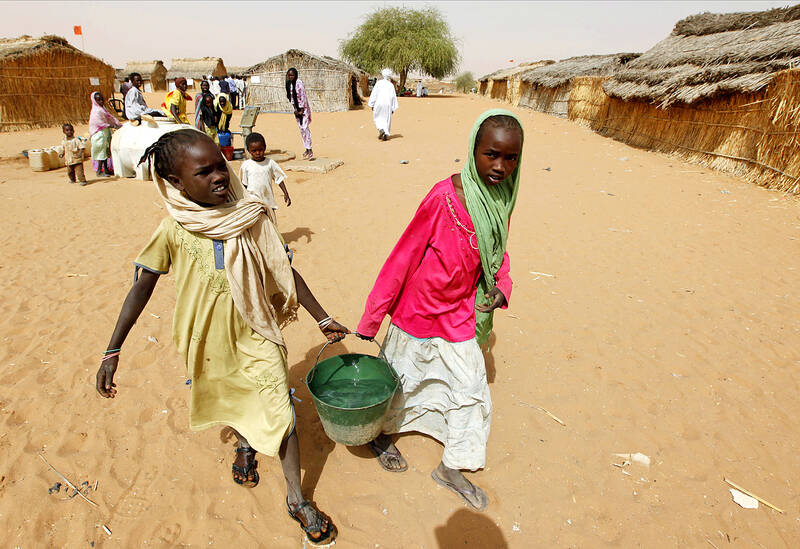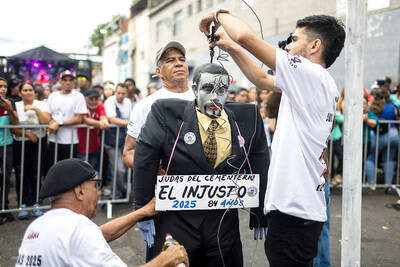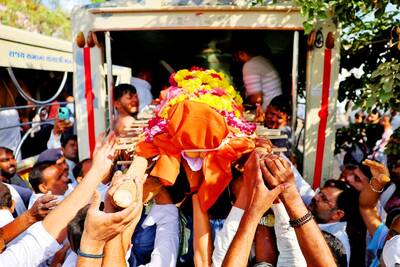Relentless violence has devastated Sudan, and large-scale fighting has escalated in and around the only capital in Sudan’s western Darfur region not held by paramilitary forces, the UN’s top humanitarian official said on Wednesday.
UN Acting Under-Secretary-General for Humanitarian Affairs and Emergency Relief Coordinator Joyce Msuya told the UN Security Council that famine has already struck Zamzam camp, about 15km from El Fasher, the capital of North Darfur State.
A large-scale humanitarian operation is “a matter of life and death,” Msuya said.

Photo: AP
Sudan plunged into conflict in the middle of April last year, when long-simmering tensions between its military and paramilitary leaders broke out in the capital, Khartoum, and spread to other regions, including Darfur.
The UN says that more than 14,000 people have been killed and 33,000 injured.
Msuya urged the council to demand that the warring government and paramilitary Rapid Support Force refrain from targeting civilians, hospitals, schools and other civilian infrastructure, and allow unimpeded delivery of humanitarian aid through all border crossings and across conflict lines.
She also called on the UN’s 193 member nations to pressure the parties “to agree to a humanitarian pause to save lives, give civilians respite and allow us to deliver assistance.”
Two decades ago, Darfur became synonymous with genocide and war crimes, particularly by the Janjaweed Arab militias, against populations that identify as central or east African. Up to 300,000 people were killed and 2.7 million were driven from their homes.
That legacy appears to have returned, with International Criminal Court prosecutor Karim Khan in January saying that there are grounds to believe both sides might be committing war crimes, crimes against humanity or genocide in Darfur.
Msuya said “the world should not abide in El Fasher the atrocities we witnessed in West Darfur” State.
In June, the Security Council adopted a resolution calling for “an immediate halt to the fighting and for de-escalation in and around El Fasher.”
Regrettably, both sides ignored the call, and fighting escalated in the past week with “constant and heavy” shelling and bombing, Msuya said.
“Civilians, especially women and children, have been hit [and] civilian sites and infrastructure — including hospitals and internally displaced persons’ camps — have been hit,” she said. “Of the three main hospitals in El Fasher, only one is functioning, although only partially following an attack that caused extensive damage in August.”
International experts last month confirmed that there is famine in Zamzam camp, which houses about 500,000 displaced people.
Msuya said close to 1.7 million people in North Darfur face “acute food insecurity,” adding that 13 other localities in Sudan have been identified as at risk of famine.
In February, Doctors Without Borders reported that a child was dying every two hours in Zamzam camp, she said.
The latest screening by the medical aid organization and the Sudanese Ministry of Health from Sept. 1 to 5 indicated that the situation was getting worse.
“About 34 percent of the children are malnourished, including 10 percent who are severely malnourished,” Msuya said.
Aid deliveries have been impeded by fighting and flooding, but Msuya said that as floodwaters subside, the UN will be able to start moving food and other assistance to El Fasher and other areas at risk of famine.
To address “the atrocious humanitarian situation,” there are two keys: A de-escalation in fighting and a willingness by both sides to facilitate access to those in need, she said.
“Be in no doubt: Without safe and predictable access and a steady supply of food and humanitarian supplies, we will see a dramatic spike in mortality — including children — in Zamzam and in other areas around El Fasher,” she said.
“The same goes for the situation across Sudan, especially in Khartoum, as well as Sennar and Jazeera states, which continue to be devastated “by relentless violence,” she added.

POLITICAL PRISONERS VS DEPORTEES: Venezuela’s prosecutor’s office slammed the call by El Salvador’s leader, accusing him of crimes against humanity Salvadoran President Nayib Bukele on Sunday proposed carrying out a prisoner swap with Venezuela, suggesting he would exchange Venezuelan deportees from the US his government has kept imprisoned for what he called “political prisoners” in Venezuela. In a post on X, directed at Venezuelan President Nicolas Maduro, Bukele listed off a number of family members of high-level opposition figures in Venezuela, journalists and activists detained during the South American government’s electoral crackdown last year. “The only reason they are imprisoned is for having opposed you and your electoral fraud,” he wrote to Maduro. “However, I want to propose a humanitarian agreement that

ECONOMIC WORRIES: The ruling PAP faces voters amid concerns that the city-state faces the possibility of a recession and job losses amid Washington’s tariffs Singapore yesterday finalized contestants for its general election on Saturday next week, with the ruling People’s Action Party (PAP) fielding 32 new candidates in the biggest refresh of the party that has ruled the city-state since independence in 1965. The move follows a pledge by Singaporean Prime Minister Lawrence Wong (黃循財), who took office last year and assumed the PAP leadership, to “bring in new blood, new ideas and new energy” to steer the country of 6 million people. His latest shake-up beats that of predecessors Lee Hsien Loong (李顯龍) and Goh Chok Tong (吳作棟), who replaced 24 and 11 politicians respectively

Young women standing idly around a park in Tokyo’s west suggest that a giant statue of Godzilla is not the only attraction for a record number of foreign tourists. Their faces lit by the cold glow of their phones, the women lining Okubo Park are evidence that sex tourism has developed as a dark flipside to the bustling Kabukicho nightlife district. Increasing numbers of foreign men are flocking to the area after seeing videos on social media. One of the women said that the area near Kabukicho, where Godzilla rumbles and belches smoke atop a cinema, has become a “real

‘WATER WARFARE’: A Pakistani official called India’s suspension of a 65-year-old treaty on the sharing of waters from the Indus River ‘a cowardly, illegal move’ Pakistan yesterday canceled visas for Indian nationals, closed its airspace for all Indian-owned or operated airlines, and suspended all trade with India, including to and from any third country. The retaliatory measures follow India’s decision to suspend visas for Pakistani nationals in the aftermath of a deadly attack by shooters in Kashmir that killed 26 people, mostly tourists. The rare attack on civilians shocked and outraged India and prompted calls for action against their country’s archenemy, Pakistan. New Delhi did not publicly produce evidence connecting the attack to its neighbor, but said it had “cross-border” links to Pakistan. Pakistan denied any connection to